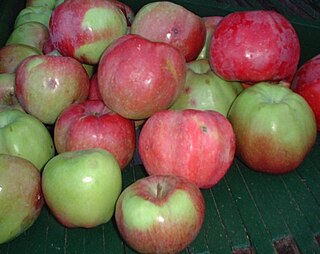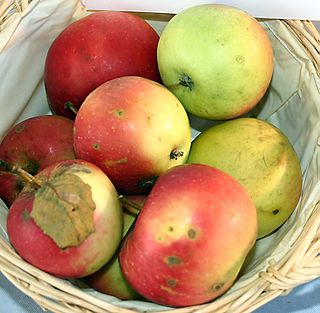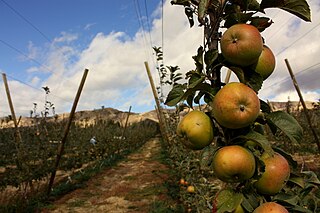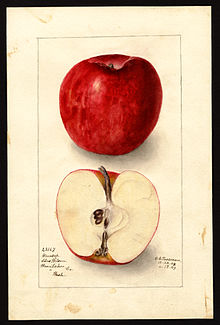
The Baldwin apple is a bright red winter apple, very good in quality, and easily shipped. It was for many years the most popular apple in New England, New York, and for export from the United States of America. No apple in the vicinity of Boston was so popular as Baldwin. It has also been known as 'Calville Butter', 'Felch', 'Late Baldwin', 'Pecker', 'Red Baldwin's Pippin', 'Steele's Red Winter', and 'Woodpecker'.

'Ralls Janet' is an apple cultivar that is also known by many other names. It has been used extensively in modern apple breeding, and has several commercially important offspring. It was grown at Monticello by Thomas Jefferson.

Antonovka is a group of late-fall or early-winter apple cultivars with a strong acid flavor that have been popular in Russia as well as in Poland and Belarus. The most popular Russian variety is Common Antonovka, from which other cultivars derive. It was developed by pioneer Russian naturalist and plant breeder Ivan V. Michurin at his experimental orchard in the Tambov Oblast and introduced in 1888.

The 'Roxbury Russet' is an apple cultivar, believed to be the oldest apple cultivar bred in the United States, having first been discovered and named in the mid-17th century in the former Town of Roxbury, part of the Massachusetts Bay Colony southwest of Boston. It is known by several other names including 'Boston Russet', 'Putnam Russet', and 'Sylvan Russet'.

Northern Spy also called 'Spy' and 'King', is a cultivar of domesticated apple that originated on the farm of Oliver Chapin in East Bloomfield, New York, in about 1840. It is popular in upstate New York.

Jonathan' is a medium-sized sweet apple, with a touch of acid and a tough but smooth skin, good for eating fresh and for cooking. Parentage = Esopus Spitzenburg x ?

The origins of the Rambo apple cultivar are unknown. It may date back to the American colony of New Sweden, when in 1637 Peter Gunnarsson Rambo, a Swedish immigrant, arrived on the Kalmar Nyckel. Swedish natural historian Pehr Kalm, who wrote Travels in North America, 1747–51, took notes of his interview with Mr. Peter Rambo, grandson of Peter Gunnarsson Rambo, recording that the "original Peter Rambo had brought apple seeds and several other tree and garden seeds with him in a box." The first Rambo apple tree was very likely grown from one of these seeds. There is no certainty, however, since the earliest documented mention of the apple variety's origin occurs in William Coxe's A View of the Cultivation of Fruit Trees, and the Management of Orchards and Cider, published in 1817. Coxe wrote only that the Rambo was much cultivated in Delaware, Pennsylvania, and New Jersey and took "its name from the families by whom it was introduced into notice."

The Newtown Pippin, also known as Albemarle Pippin, is an American apple that originated in the late 17th or early 18th century and is still cultivated on a small scale. At one time, there were two very similar apple cultivars known as the 'Yellow Newtown' and 'Green Newtown', one of which perhaps originated as a sport of the other.

The Styre or Stire, also known as the Forest Styre, was an old English variety of cider apple which was formerly common in the Forest of Dean. It is currently thought to be extinct, but may still survive in old orchards or gardens.

The Harrison cider apple is one of the most famous 18th-century American cider apples, primarily used for the production of apple cider. Grown in New Jersey before and after the American Revolution, it fell out of favor by 20th century. The Harrison cider apple was considered lost until it was recovered in Livingston, New Jersey at an old cider mill in September 1976.

A 'Stayman' is a triploid apple cultivar developed in 1866 by Joseph Stayman of Leavenworth County, Kansas; it was sold by nurseries from 1895. 'Stayman' apples remain a locally popular cultivar of apples where grown.

Bismarck is an apple cultivar. The fruit from the tree is used for cooking due to its sharp flavour and is most commonly pureed when cooking.

'Tompkins King' is a triploid cultivar of apple, also called 'King' or 'King of Tompkins County'. It was thought to have originated at Jacksonville in Tompkins County, New York, but Liberty Hyde Bailey investigated the tree there, and discovered that it was grafted. The cultivar was apparently brought from Warren County, New Jersey in 1804.

Golden Russet is an old American cultivar of domesticated apple which is excellent for fresh eating as well as for apple cider production. It is a russet apple and is therefore especially used as a cider apple. It is sometimes known as 'English Golden Russet', and has frequently been confused with 'English Russet'.

Reinette du Canada or Canadian Reinette is, despite its name, an old French cultivar of domesticated apple. It is a reinette type of golden apple, with much russeting, which keeps shape in cooking and is mainly used for that purpose especially in apple strudel.

Wolf River is an American cultivar of domesticated apple, which originates from the shores of the Wolf River of Wisconsin, in the United States of America, known since 1875. The tree is exceptionally frost hardy and generally disease resistant, and thus keeps well in storage. The fruit usually ripens mid-September to early October. It is large, commonly weighing over a pound, and fairly sweet with a distinctive red and yellow appearance. It has many culinary uses, as it keeps its shape well when cooked.
'Autumn Bough' is an early ripening cultivar of domesticated apple also known by various other names including 'Montgomery Sweet', 'Philadelphia Sweet', 'Sweet Bellflower', 'Sweet Harvest', and 'White Sugar'.

Hawley is a large yellow apple cultivar that is used for eating fresh. Although the fruit are delicious, the tree is not very productive, and the fruit are often blemished or rot at the core. It is therefore good as a home orchard tree, but not commercially profitable. The Hawthornden apple has also been incorrectly known as Hawley.

'Sops of Wine' refers to two similar old English apple cultivars that have flesh stained with dark red, looking like bread soaked in wine. One of them is also known as 'Rode Wyn Appel' and 'Sapson'. They have also been known as 'Shropshirevine', 'Strawberry', and 'Washington'.
The Poveshon, sometimes "Povershon", is an 18th-century American cider apple, primarily used for the production of apple cider. Grown in New Jersey before and after the American Revolution, it became obsolete by the 20th century as the cider industry in the state declined. It is considered lost, though it has possibly been rediscovered.


















